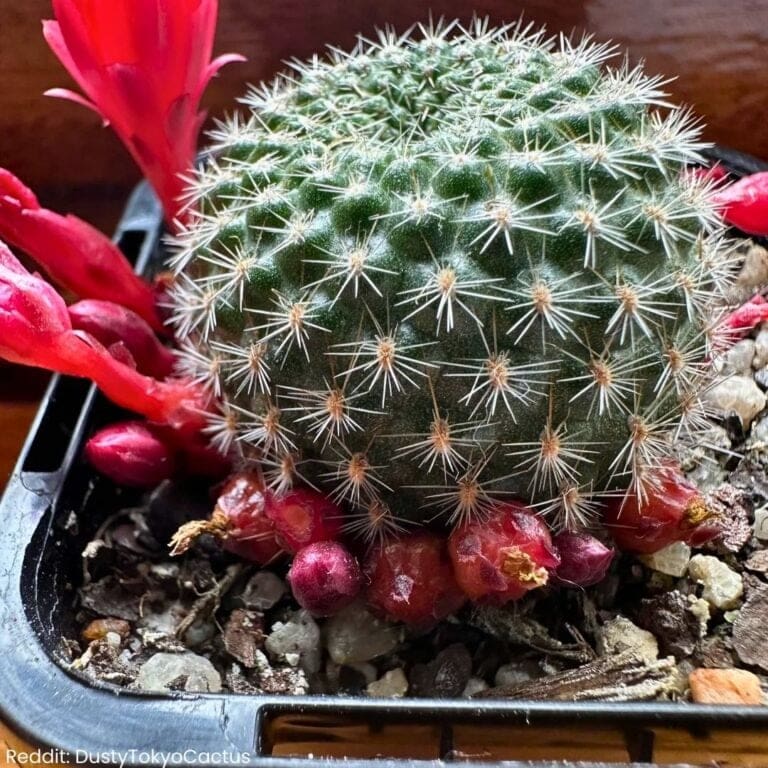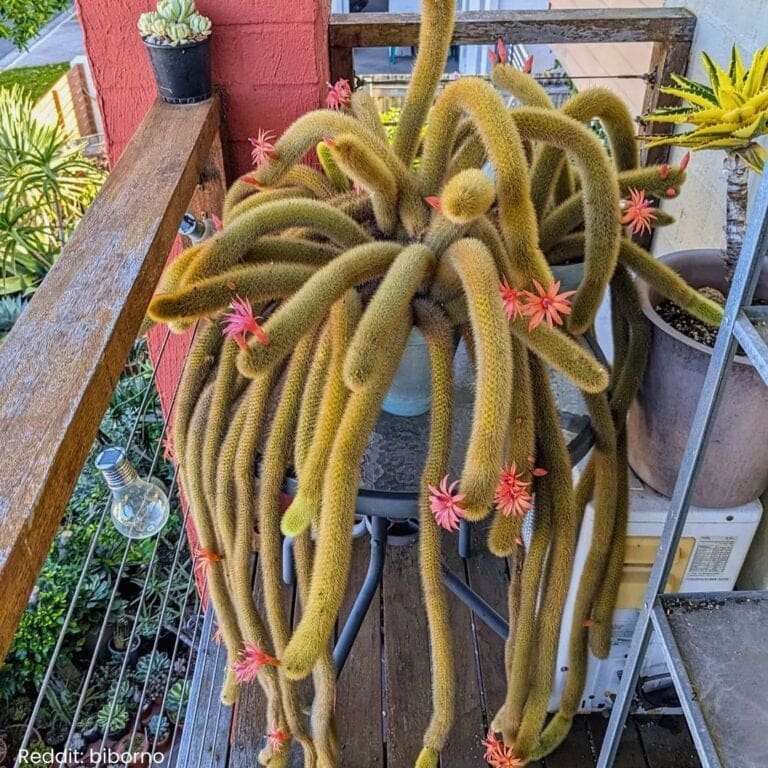How To Care For A Queen of the Night Cactus?
I’ve always loved caring for my Queen of the Night cactus. Its stunning, fragrant flowers only bloom at night and make any garden feel magical.
It might look like a tricky plant, but caring for it is easier than you’d think.
Make sure to water it sparingly and keep it in bright, indirect sunlight.
I remember when I first got mine. I was worried about overwatering. It turns out these beauties prefer dry soil. 🌵
Now, I check the soil before watering. If it’s dry to the touch, it’s time to give it a drink!
Are you considering getting one? They’re such conversation starters!
Imagine having friends over and casually mentioning that your cactus blooms under the moonlight. 🌙
Curious about anything else? Let’s dive in and keep these cacti thriving together!
Please note: Simplify Plants is reader-supported. As an Amazon Associate, I earn from qualifying purchases made by our readers with no extra cost added to you all! Some links in the post are affiliate links and I get a commission from purchases made through links in the post.
Getting to Know Your Queen of the Night Cactus

Let me tell you about my Queen of the Night cactus, a fascinating plant that blooms only at night! This beauty is known for its large, fragrant white flowers. 🌸
Ever seen a flower that blooms just once a year? That’s her magic.
Fun Fact: The Latin name for this plant is Epiphyllum oxypetalum. Impressive, right? 😊
It’s often called the “Orchid Cactus” because of its delicate blooms. Have you ever wondered why it’s called “Queen”?
Because she truly steals the show when in bloom!
Caring for my cactus is easier than you’d think.
It thrives in indirect sunlight and enjoys a roomy pot for its wide-spreading roots.
I water it sparingly, roughly once a week, making sure the soil is dry between waterings.
Too much water can lead to root rot—yikes! 🚫
I like to move my cactus outdoors during summer. It loves a warm balcony or patio.
Imagine having a nighttime party and this exquisite flower unfolds, stealing the spotlight. Instant party hit! 🎉
Curious about its origin? The Queen of the Night comes from the tropical rainforests of Mexico and South America.
It’s adapted to growing on trees, absorbing moisture from the air. Isn’t it cool how nature works?
Have you ever experienced the magic of a cactus flower opening at night? If not, owning a Queen of the Night might just be what you need. 🌟
Ideal Growing Conditions
Getting your Queen of the Night cactus to thrive is all about setting the right conditions. From light to soil, little adjustments make all the difference. 🌵
Let’s explore what your cactus needs to grow its best.
Light Requirements
These beauties enjoy a mix of bright, indirect light. Direct sunlight can be too intense and may damage their leaves.
I’ve found a spot near a window with sheer curtains works perfectly.
During the winter months, don’t stress if they’re not getting as much light. Just be sure to keep them away from complete darkness.
Do you have a favorite spot for your indoor plants?
Temperature and Humidity
This cactus prefers temperatures between 65°F and 75°F. 🏡
They can handle a bit of a drop at night, mimicking their natural desert environment.
Keep them away from cold drafts like open windows in the winter and avoid placing them near heating vents.
When it comes to humidity, they’re pretty chill. Moderate humidity levels are just fine, so no need to run a humidifier all the time.
Potting and Soil Preferences
I always make sure to use well-draining soil. A cactus mix or sandy soil works great.
Picking a pot with drainage holes is super important, too, to prevent root rot.
When repotting, remember: not too large a pot! The cactus likes being a bit snug in its home.
Have you found the perfect pot yet? 🤔
I hope these tips help your Queen of the Night flourish! 🌿
Planting and Repotting Guidelines

When I was first planting my Queen of the Night cactus, I felt like a gardening superhero. 🌵
The pot you choose really matters! Go for a pot that’s a little wider than it is deep. This cactus loves room to spread its roots.
Soil is key! Use a well-draining mix, like cactus or succulent soil. Add some perlite or sand if you have it.
Ever tried mixing your own soil blend? It’s kind of like baking, but without the mess!
I bet you’re wondering about repotting.
Honestly, I do this every two to three years. Look for signs—roots poking out of the drainage holes, or the plant looks overcrowded.
It’s like when your favorite sneakers don’t fit anymore. Time to size up!
Repotting can be a bit prickly. 😅
Wear gloves to protect your hands. Gently tip the plant out, shake off excess soil, and trim any dead or rotting roots.
You know that feeling after a good haircut? That’s your cactus, feeling fresh and ready!
After repotting, hold off on watering for a week. Let the roots settle into their new digs first.
It’s like letting your phone charge fully before you take it for a spin.
Have you tried planting or repotting yours yet? 🪴
Share your experiences! I’m always up for swapping tips and tricks.
Watering Routine

Caring for your Queen of the Night cactus means understanding how often to water and using the right techniques. 🌵
Let’s dive into the details to ensure your plant thrives.
Watering Frequency
I’ve learned that getting the watering schedule right is crucial for a Queen of the Night cactus.
These plants don’t need much water.
During the growing season in spring and summer, I water mine every two weeks. It’s important to let the soil dry out between watering.
In fall and winter, when the cactus rests, I only water it once every month.
Have you ever noticed too much water can cause root rot? So, I make sure not to water too often, especially in colder months.
Best Water Practices
When it comes to the best way to water, I always check if the top inch of soil is dry.
If it is, I water deeply, letting it run through the pot’s drainage holes.
Avoid soggy soil! 🌼
It’s like giving your plant a good drink and letting excess water drain away.
Using lukewarm water helps keep the plant happy.
Sometimes, I throw in a funny little ritual of “talking” to my plant as I water it. Why not? 😊
You might discover it grows better with some friendly conversation—at least, I like to think so!
What’s your watering routine like?
Fertilizing for Optimal Growth

When it comes to feeding my Queen of the Night cactus, I’ve found that a little love goes a long way. 🌵
I usually use a balanced cactus fertilizer, which I dilute to half strength. Fertilizing in the spring and summer helps it grow healthy.
I love how feeding the plant makes a noticeable difference in its growth.
Do you feel the same way? It’s amazing how these simple steps make such a big impact!
Here’s a quick guide on when to fertilize:
- Spring: Once a month
- Summer: Once a month
- Fall and Winter: Stop fertilizing
It’s important to let the cactus rest in the colder months.
I think it’s like their little nap time. 😴 This helps them save energy for blooming.
When applying the fertilizer, I avoid getting it on the plant itself. That can damage the leaves.
Instead, I gently water the soil around it.
This way, my plant gets all the nutrients it needs right where it can use them.
Got any tips of your own? Share them with me!
Pruning and Maintenance
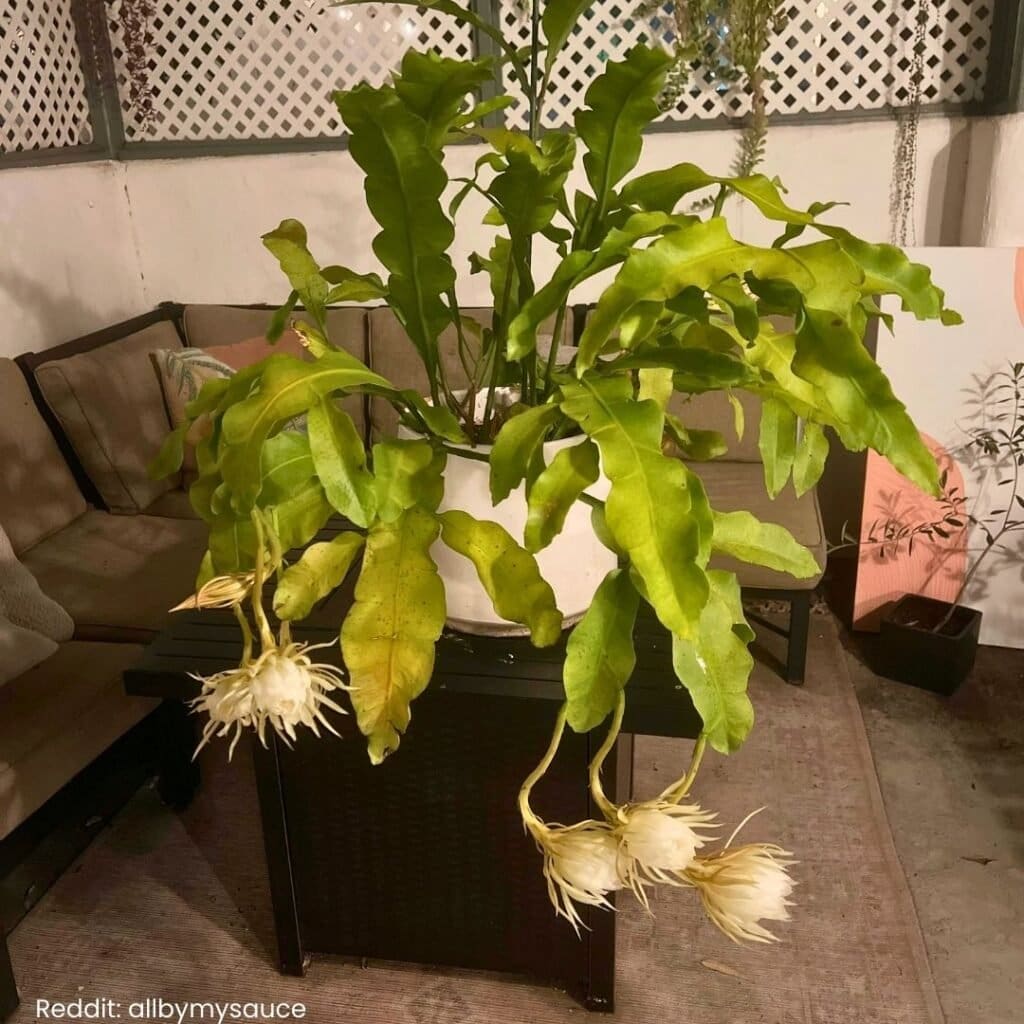
Keeping the Queen of the Night cactus healthy involves some simple pruning and regular maintenance tasks. Let’s look at how to do these.
Regular Pruning
I keep my Queen of the Night cactus looking tidy by trimming it now and then.
Pruning helps the plant grow better and gets rid of dead or damaged parts.
I always check the stems and cut back any that look dead or unhealthy.
How do I know what to cut?
I look for any sagging, brown, or broken branches. I use sharp, clean scissors or pruners.
And yes, I even wear gloves to protect my hands from any sharp bits! 🌵✨
After pruning, I notice my cactus perks up and looks much healthier.
It’s a little like a fresh haircut, making my plant happy and neat.
Seasonal Maintenance
During different seasons, my Queen of the Night requires a bit of extra attention.
In spring, I give it some special cactus fertilizer to boost its growth. It helps the cactus prepare for blooming those amazing flowers at night.
In the colder months, I move my plant indoors or to a sheltered spot to avoid the chill.
Do you have a good space for your cactus during winter? Keeping it warm is key. ❄️🌸
Also, I always check the soil. If it feels too wet or dry, I adjust watering as needed.
Remember, a little care in each season keeps the cactus thriving all year round.
By doing these simple tasks, I ensure my Queen of the Night remains a stunning showpiece in my home! 🌿😊
Propagation Techniques
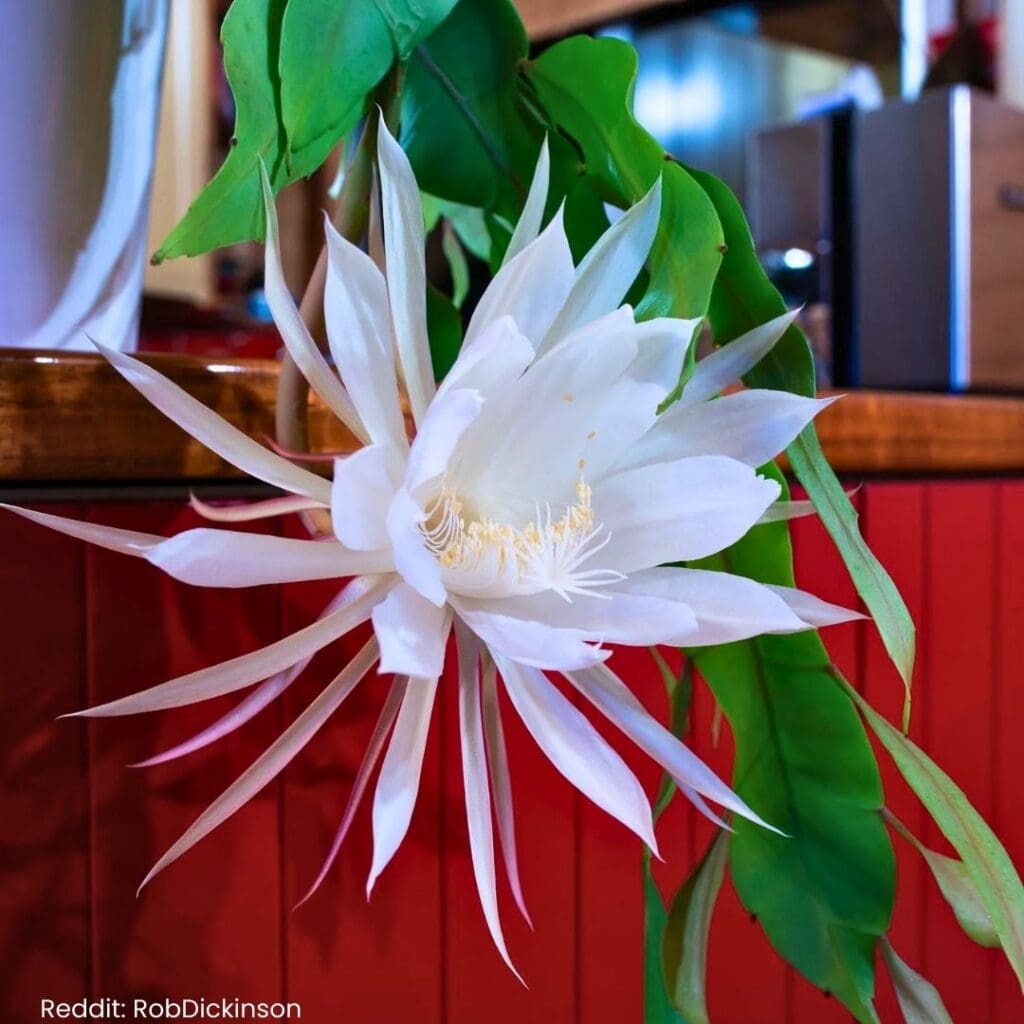
Growing more Queen of the Night cacti can be really fun. You can use stem cuttings or seed germination to start new plants.
Both methods are pretty straightforward and give you an exciting way to expand your cactus collection.
Ready to get your hands dirty? Let’s do this! 🌵
Stem Cutting Method
I love this method because it’s simple and pretty quick.
First, grab a healthy stem with at least 2 segments. Use a clean, sharp knife to cut it off.
Let the cutting dry for a couple of days so the cut end heals—this helps prevent rot.
After it’s dry, plant the cutting upright in well-draining soil.
Water it sparingly, just enough to keep the soil slightly damp.
In a few weeks, roots will start to form. Keep it in a warm spot with filtered sunlight.
Seeing new growth is super rewarding! 🙌
Seed Germination
Germinating seeds takes a bit longer but is totally worth it!
Start by soaking the seeds overnight in warm water. This helps soften the outer shell.
Then, plant them in a mix of cactus soil and sand. You can sprinkle them on top and cover lightly with soil.
These seeds need warmth.
I keep them in a bright spot but away from direct sunlight.
It’s important to mist the soil occasionally to keep it moist, but don’t overwater.
After a few weeks, tiny sprouts will appear. It feels like magic every time. 🌱
Want to try these methods? Which one seems more your style? Let me know—I’d love to hear your thoughts! 🤔
Preventing and Managing Pests and Diseases
Keeping the Queen of the Night cactus healthy isn’t just about watering. It’s also about watching for pests and diseases.
Let’s get down to business, shall we? 🕵️♂️
First, inspect your cactus regularly. Check for signs of unwanted guests like mealybugs and spider mites. 🤔
Ever noticed tiny white fluff or webbing? Those are clues!
Prevention tip: Keep your cactus clean.
Dust off the leaves gently with a damp cloth. This removes potential hiding spots for pests.
Plus, a clean cactus is a happy cactus. ✨
Got pests? Don’t panic!
Use a mix of water and a few drops of mild dish soap.
Spray this on the cactus and wipe off with a soft cloth. It’s like giving your cactus a little spa day! 🧖♀️
If disease strikes, like root rot (yikes!), it’s usually due to overwatering.
Use well-draining soil to help prevent this. Keeping the roots dry is key.
Remember, cacti like it dry!
Here’s a quick recap of my go-to tips:
- Check regularly for pests
- Keep the cactus clean
- Use mild soap mix for pests
- Ensure well-draining soil
🌵 Have you faced any cactus challenges? Share in the comments! Let’s keep our cacti thriving together! 🌱✨
Are you ready to beat those pests and manage diseases like a pro? Share your thoughts or questions below!
Troubleshooting Common Issues
I’ve found that taking care of a Queen of the Night cactus can be pretty smooth, but a few things can go wrong. 🌵
Sometimes the leaves might look a bit droopy. This usually means it’s thirsty, so a good watering should perk it up.
Yellow leaves? Not a great sign. This can be from too much water, or poor drainage.
I make sure to check the pot’s drainage holes and let the soil dry out between waterings.
Do you see any differences after adjusting the watering schedule?
Let’s talk about pests. Spider mites or aphids might make an appearance.
When I spot these, I wipe the leaves with a damp cloth or use a gentle insecticidal soap. Do you have a favorite way to keep pests at bay?
Ever had your cactus refuse to bloom? It can be frustrating.
I ask myself: is it getting enough indirect light? Maybe it needs more darkness at night, just like us! 😊
Temperature is key, too.
The Queen of the Night enjoys warmth. If it gets too cold, you might notice less growth. Moving it to a warmer spot often helps.
Feel free to explore with these solutions and find what works best for you. 🌿
Blooming Tips and Tricks
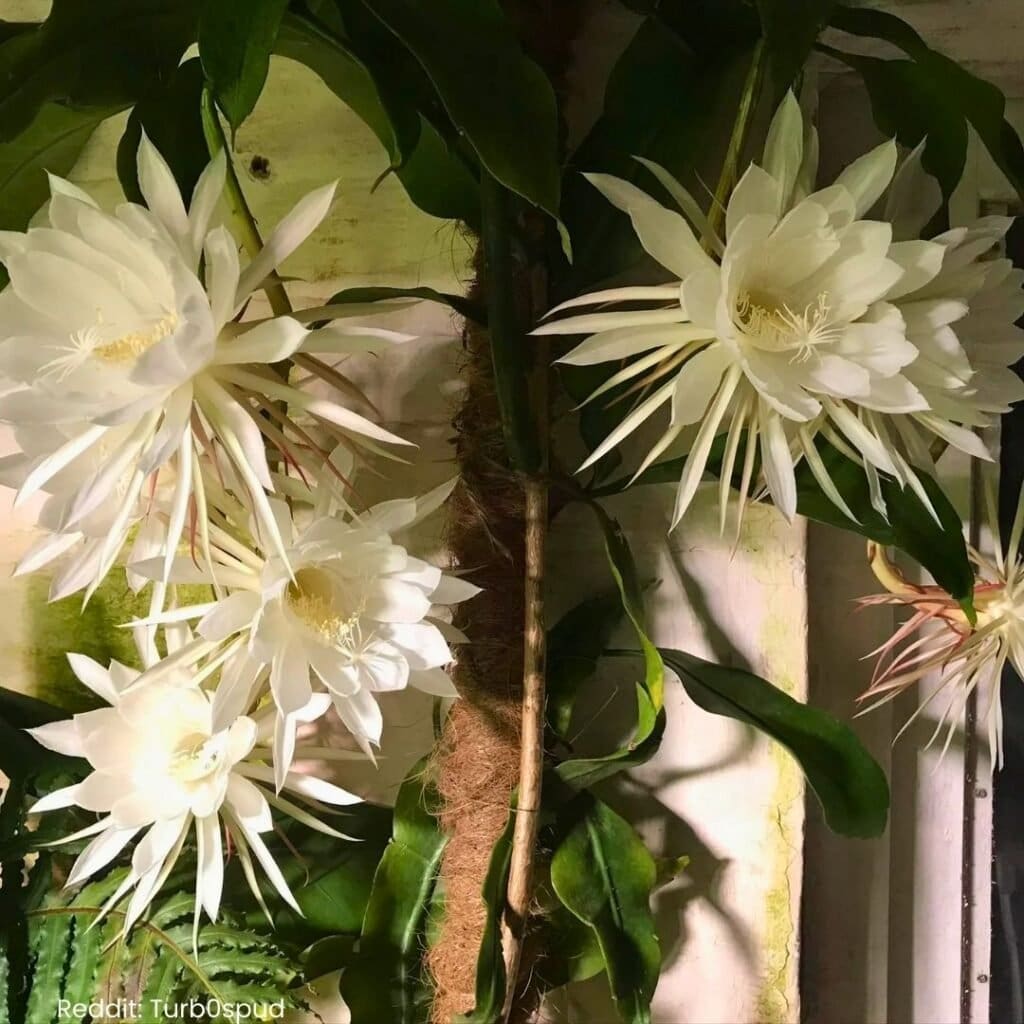
Caring for a queen of the night cactus is like inviting a special guest to your home. You want everything to be just right, especially when it’s time for that amazing bloom! 🌼
Let me share some tips with you.
First, make sure your cactus gets enough rest.
It blooms best when it’s well-rested, so keep it in the dark for about 12-14 hours at night. This helps trigger blooming.
When it comes to water, less is more.
I water mine sparingly, just enough to keep the soil slightly moist. Overwatering can make it cranky. No one wants a soggy cactus! 💦
Temperature matters too.
I keep my cactus in a warm spot with temperatures around 75°F during the day and a bit cooler at night. This mimics its natural environment.
Feeding your cactus some cactus fertilizer during the growing season can also be a good idea.
I do this every month in spring and summer. It’s like giving your plant a little energy drink.
If you want your cactus to bloom at a specific time, try moving it to a slightly cooler room during its flower-inducing period.
Some people swear it works wonders!
Ever tried chatting with your cactus? I do!
Just a friendly chat can provide the perfect vibes it needs. Who knows, it might help, and it’s fun to try! 😊
Have any blooming stories to share? Let’s help each other grow our green thumbs!
Winter Care Special Considerations
Hey there! Winter can be a tricky time for Queen of the Night cactus enthusiasts like me. Let’s make sure our cacti are safe and sound until spring! 🌵
First, temperature is important.
I make sure my cactus is in a spot where it’s between 50-60°F (10-15°C). Too cold, and it might struggle. Ever had a cold cactus? Not fun. 🥶
I also adjust my watering routine.
During winter, I water sparingly, maybe once every six weeks. Too much water can lead to root rot. A thirsty cactus is better than an over-watered one!
Light is my next concern.
Even if it’s winter, my cactus still needs some light. I place it near a south-facing window to catch some sun. But not too close, or it might get fried! 🌞
I find it helpful to rotate my cactus every few weeks.
This keeps it from growing lopsided. Nobody wants a cactus leaning awkwardly, right? 😄
For humidity, I remember that these guys love it dry.
So, no misting during winter! It’s like giving it a wet blanket when it just wants to be cozy.
If you have questions or funny cactus stories, share them with me! Let’s keep our cacti happy together. 🌵✨
Frequently Asked Questions
Caring for a Queen of the Night cactus means giving it just the right conditions.
With questions like watering tips, blooming time, pruning, and some fascinating flower facts, I’ve got everything you need to know about this unique plant.
Ready to become a cactus pro? Let’s dive in! 🌵
What are the ideal indoor conditions for a Queen of the Night cactus?
To keep my Queen of the Night happy, I make sure it gets bright, indirect light.
A spot near a window with filtered sunshine is perfect. 🌞
I also try to keep the temperature indoors around 60-70°F. It’s like the cactus version of a cozy sweater! 😊
How often should a Queen of the Night cactus be watered?
Watering my cactus can be tricky.
During the growing season (spring and summer), I water it every 1-2 weeks, letting the soil dry out between drenching.
In fall and winter, I cut back to once a month. Too much water and it gets soggy!
When does the Queen of the Night typically bloom?
This cactus is a nighttime star! 🌟
My Queen of the Night usually blooms once a year, often in late spring or early summer. The flowers open at night and only last a few hours. It’s like a secret garden party!
What are the proper pruning techniques for a Queen of the Night plant?
Pruning my cactus involves snipping off dead or overgrown stems.
I always use clean scissors and make cuts close to the base. This helps it stay healthy and contain its wild beauty. Trimming also encourages new growth.
Can you share some interesting facts about the Queen of the Night flower?
The Queen of the Night flower is a bit of a spectacle.
It’s famous for its rare and brief blooming time. Did you know it also gives off a sweet fragrance? It’s like a natural air freshener! 🌼
It’s not every day you meet a flower with such mystique.
What should I know about the Queen of the Night cactus before purchasing one?
Before bringing one home, I keep in mind that it’s a night owl with specific light and water needs.
It also grows quite large, so space is essential.
It’s worth it for such a fascinating plant!
Ready to join the Queen of the Night fan club? 😊
Recommended Garden Supplies
| Product Image | Our Recommended Gardening Supplies | Check Offers! |
|---|---|---|
Top Top
Top
Top
Top
Top
Top
Top
Top | rePotme Houseplant and Tropical Classic Potting Soil Mix | Check Offer On Amazon |
 Top
Top
Top
Top
Top
Top
Top
Top | Espoma Organic Indoor Plant Food | Check Offer On Amazon |
 Top
Top
Top
Top
Top
Top
Top
Top | GooingTop LED Grow Light 6000K Full Spectrum Clip Plant Growing Lamp | Check Offer On Amazon |
 Top
Top
Top
Top
Top
Top
Top
Top | Soil Moisture Meter | Check Offer On Amazon |
 Top
Top
Top
Top
Top
Top
Top
Top | Govee Hygrometer Thermometer, Bluetooth Enabled! | Check Offer On Amazon |
 Top
Top | LEVOIT Humidifiers for Large Room(Best For Plants) | Check Offer On Amazon |
 Top
Top
Top
Top
Top
Top
Top
Top | Upgraded DIY Automatic Drip Irrigation Kit, 15 Potted Houseplants Support | Check Offer On Amazon |
 Top
Top
Top
Top
Top
Top
Top
Top | Stainless Steel Heavy Duty Gardening Tool Set | Check Offer On Amazon |
 Top
Top
Top
Top
Top
Top
Top
Top | Bonide Insecticidal Soap | Check Offer On Amazon |
 Top
Top
Top
Top
Top
Top
Top
Top | Bonide 32 oz Spray Neem Oil for Organic Gardening | Check Offer On Amazon |
 Top
Top
Top
Top
Top
Top
Top
Top | Garden Safe Fungicide | Check Offer On Amazon |


